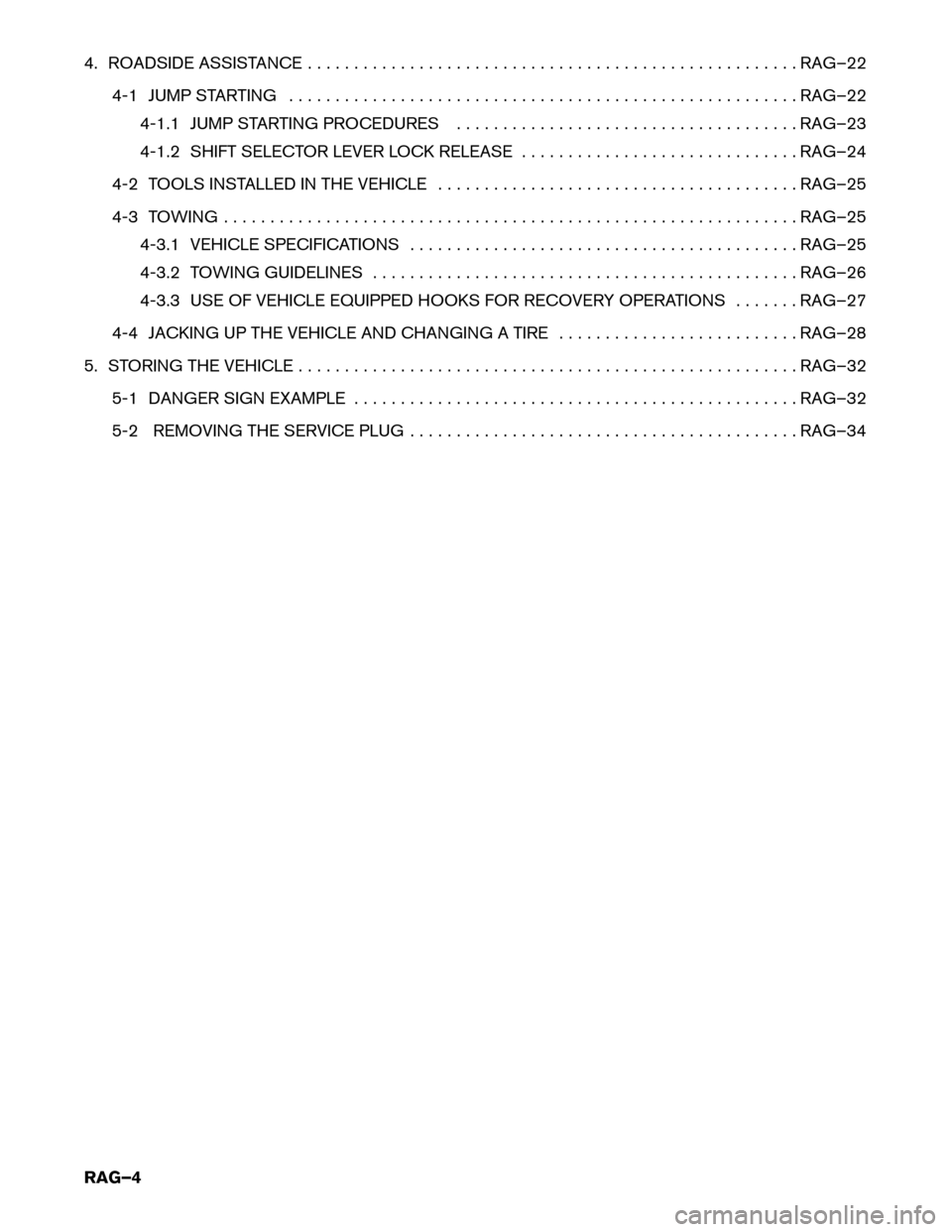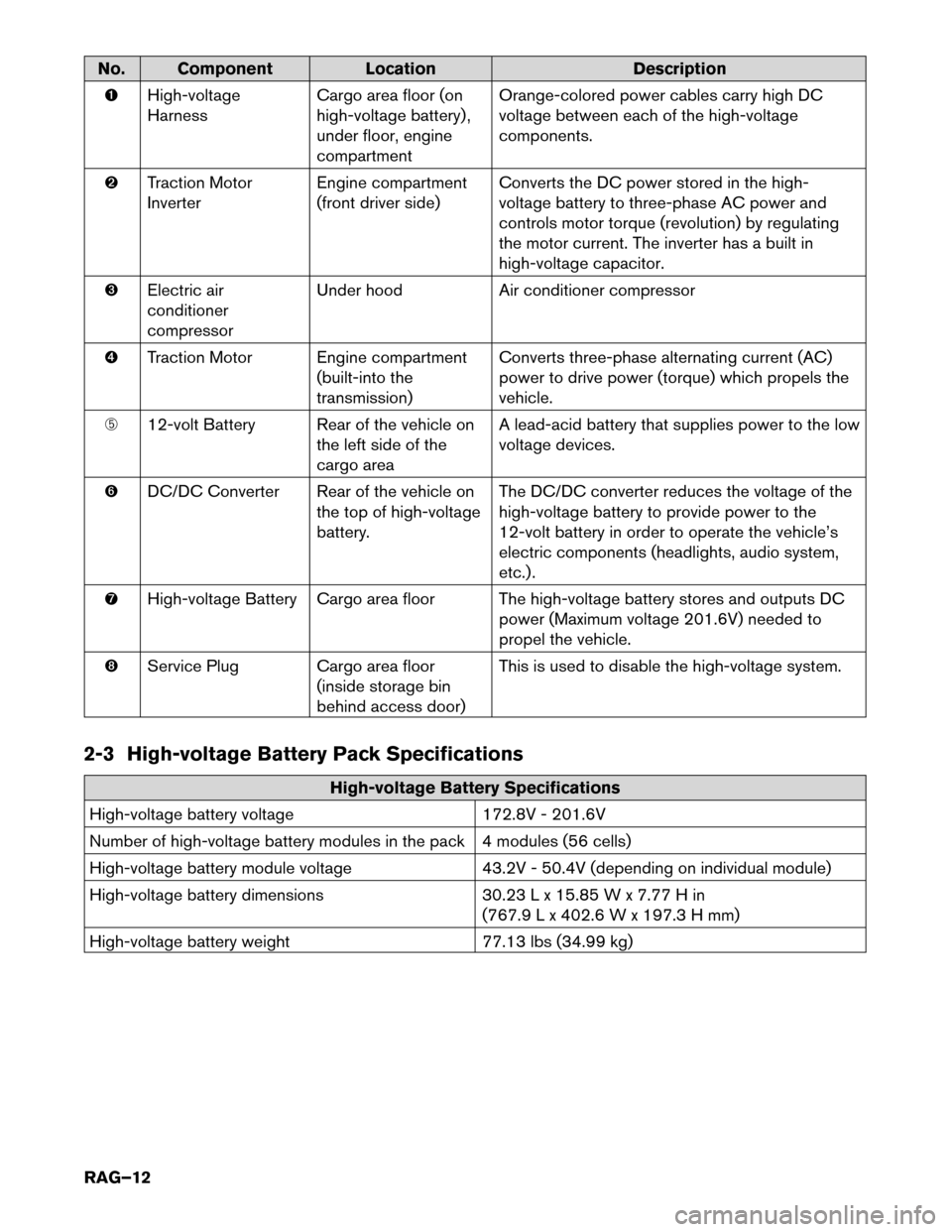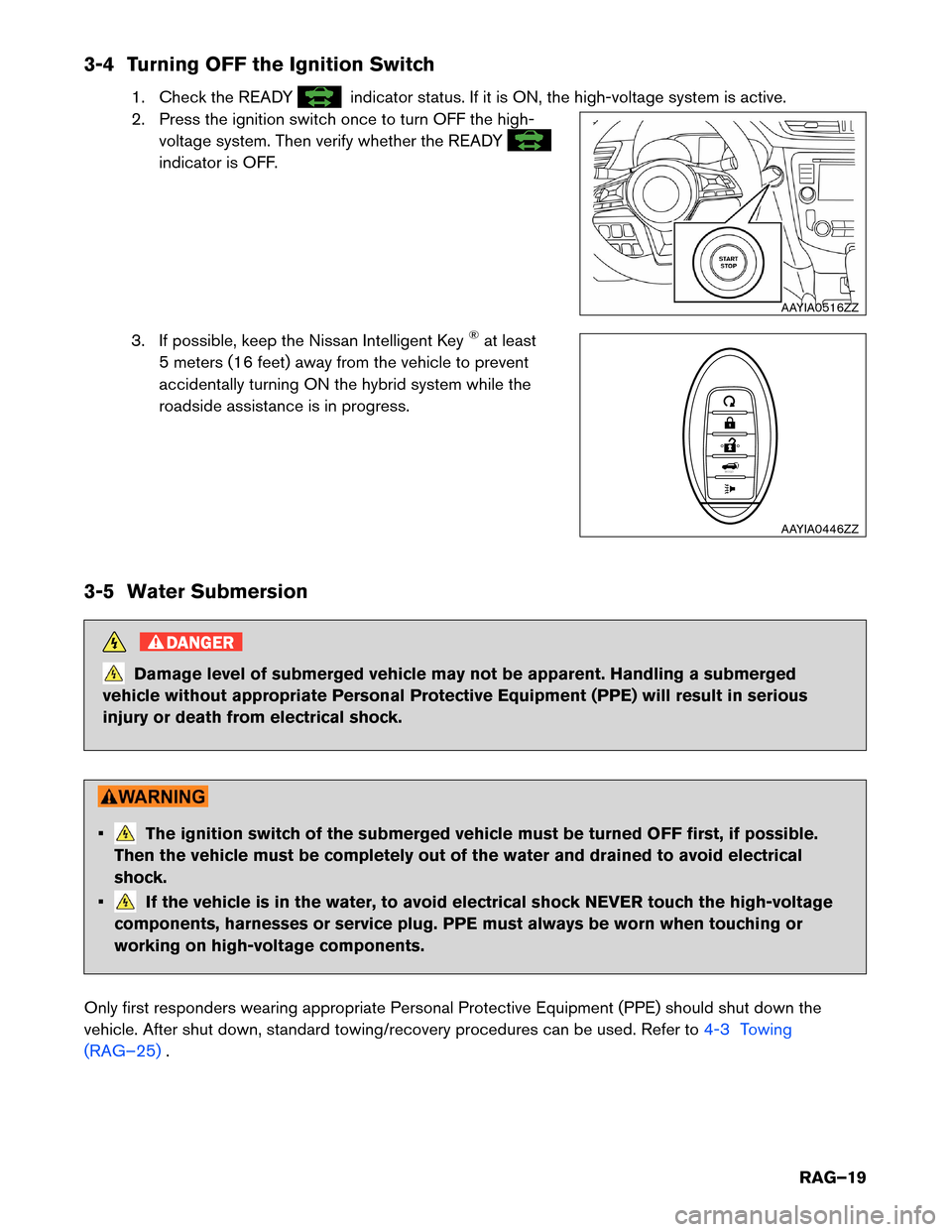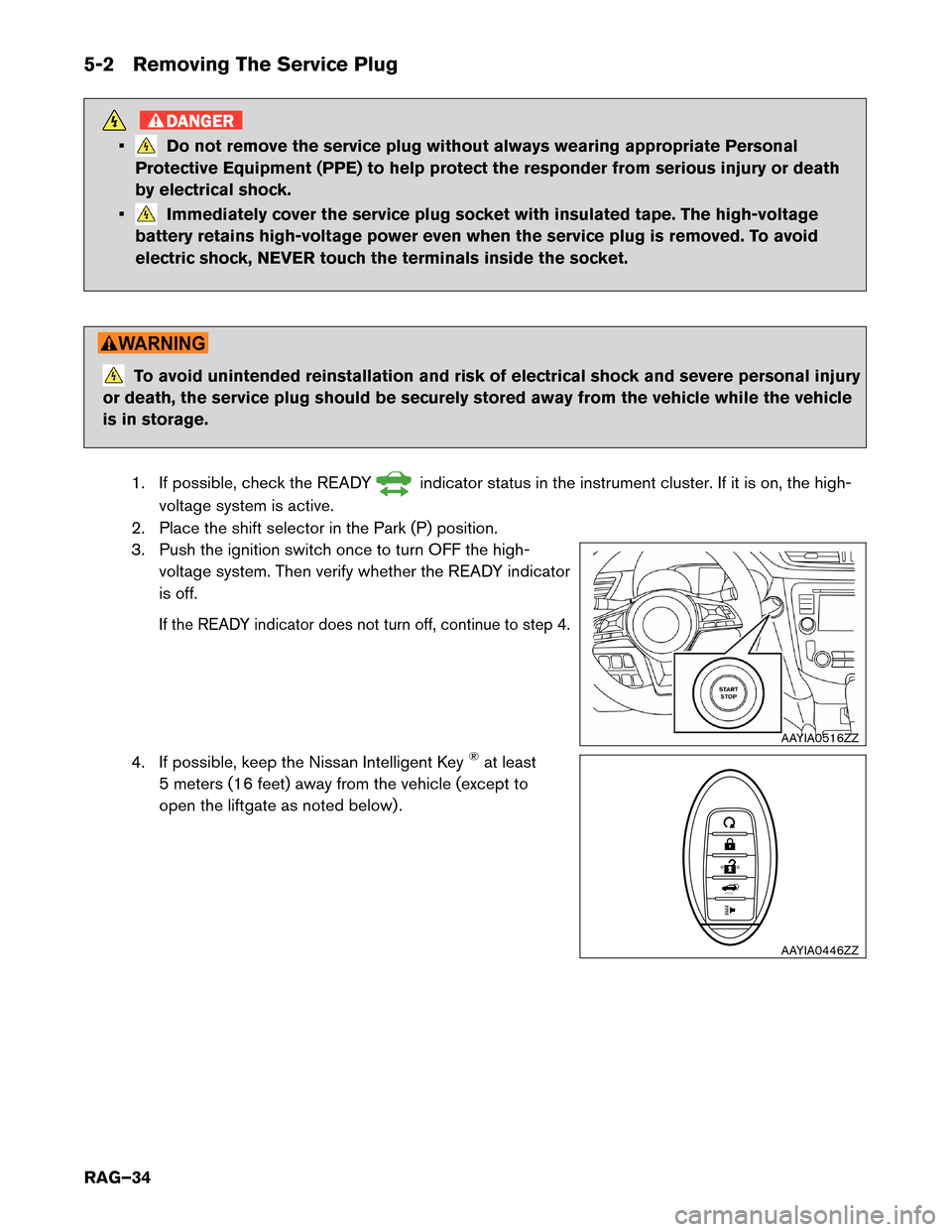Page 4 of 38

4. ROADSIDE ASSISTANCE . . . . . . . . . . . . . . . . . . . . . . . . . . . . . . . . . . . . . . . . . . . . . . . .
. . . . . RAG–22
4-1 JUMP STARTING . . . . . . . . . . . . . . . . . . . . . . . . . . . . . . . . . . . . . . . . . . . . . . . . . . . . . . . RAG–22 4-1.1 JUMP STARTING PROCEDURES . . . . . . . . . . . . . . . . . . . . . . . . . . . . . . . . . . . . . RAG–23
4-1.2 SHIFT SELECTOR LEVER LOCK RELEASE . . . . . . . . . . . . . . . . . . . . . . . . . . . . . . RAG–24
4-2 TOOLS INSTALLED IN THE VEHICLE . . . . . . . . . . . . . . . . . . . . . . . . . . . . . . . . . . . . . . . RAG–25
4-3 TOWING . . . . . . . . . . . . . . . . . . . . . . . . . . . . . . . . . . . . . . . . . . . . . . . . . . . . . . . . . . . . . . RAG–25 4-3.1 VEHICLE SPECIFICATIONS . . . . . . . . . . . . . . . . . . . . . . . . . . . . . . . . . . . . . . . . . . RAG–25
4-3.2 TOWING GUIDELINES . . . . . . . . . . . . . . . . . . . . . . . . . . . . . . . . . . . . . . . . . . . . . . RAG–26
4-3.3 USE OF VEHICLE EQUIPPED HOOKS FOR RECOVERY OPERATIONS . . . . . . . RAG–27
4-4 JACKING UP THE VEHICLE AND CHANGING A TIRE . . . . . . . . . . . . . . . . . . . . . . . . . . RAG–28
5. STORING THE VEHICLE . . . . . . . . . . . . . . . . . . . . . . . . . . . . . . . . . . . . . . . . . . . . . . . . . . . . . . RAG–32 5-1 DANGER SIGN EXAMPLE . . . . . . . . . . . . . . . . . . . . . . . . . . . . . . . . . . . . . . . . . . . . . . . . RAG–32
5-2 REMOVING THE SERVICE PLUG . . . . . . . . . . . . . . . . . . . . . . . . . . . . . . . . . . . . . . . . . . RAG–34
RAG–4
Page 5 of 38
1. About the Rogue HYBRID
This
hybrid electric vehicle (HEV) uses two types of batteries. One is a 12-volt battery that is the same as
the battery in vehicles powered by internal combustion engines. The 12-volt battery is located behind
the second row seat with battery cable access underneath the cargo area luggage board. The other is the
high-voltage battery for the traction motor which propels the vehicle. The high-voltage battery is located
behind the second row seat with service plug access through the cargo area storage bin.
When the high-voltage battery level is low, engine output is used to generate power from the traction motor
and charge the high-voltage battery. Additionally, the vehicle system can recharge the high-voltage battery
by converting driving force into electricity while the vehicle is decelerating or being driven downhill. This
is called regenerative charging.
RAG–5
Page 12 of 38

No. Component
LocationDescription
� High-voltage
Harness Cargo
area floor (on
high-voltage battery) ,
under floor, engine
compartment Orange-colored power cables carry high DC
voltage between each of the high-voltage
components.
� Traction Motor
Inverter Engine compartment
(front driver side) Converts the DC power stored in the high-
voltage battery to three-phase AC power and
controls motor torque (revolution) by regulating
the motor current. The inverter has a built in
high-voltage capacitor.
� Electric air
conditioner
compressor Under hood
Air conditioner compressor
� Traction Motor Engine compartment
(built-into the
transmission) Converts three-phase alternating current (AC)
power to drive power (torque) which propels the
vehicle.
� 12-volt Battery Rear of the vehicle on
the left side of the
cargo area A lead-acid battery that supplies power to the low
voltage devices.
� DC/DC Converter Rear of the vehicle on
the top of high-voltage
battery. The DC/DC converter reduces the voltage of the
high-voltage battery to provide power to the
12-volt battery in order to operate the vehicle’s
electric components (headlights, audio system,
etc.) .
� High-voltage Battery Cargo area floor The high-voltage battery stores and outputs DC
power (Maximum voltage 201.6V) needed to
propel the vehicle.
� Service Plug Cargo area floor
(inside storage bin
behind access door) This is used to disable the high-voltage system.
2-3 High-voltage Battery Pack Specifications High-voltage Battery Specifications
High-voltage
battery voltage 172.8V - 201.6V
Number of high-voltage battery modules in the pack 4 modules (56 cells)
High-voltage battery module voltage 43.2V - 50.4V (depending on individual module)
High-voltage battery dimensions 30.23 L x 15.85 W x 7.77 H in
(767.9 L x 402.6 W x 197.3 H mm)
High-voltage battery weight 77.13 lbs (34.99 kg)
RAG–12
Page 14 of 38
The following warning label is applied to the service plug access cover located inside the cargo area.
The
following warning label is applied to the high-voltage battery located inside the cargo area. AAYIA0455ZZ
AAYIA0456ZZ
RAG–14
Page 19 of 38

3-4 Turning OFF the Ignition Switch
1. Check the READY indicator status. If it is ON, the high-voltage system is active.
2.
Press the ignition switch once to turn OFF the high-
voltage system. Then verify whether the READY indicator is OFF.
3.
If possible, keep the Nissan Intelligent Key
®at least
5 meters (16 feet) away from the vehicle to prevent
accidentally turning ON the hybrid system while the
roadside assistance is in progress.
3-5 Water Submersion DANGER
Damage level of submerged vehicle may not be apparent. Handling a submerged
vehicle
without appropriate Personal Protective Equipment (PPE) will result in serious
injury or death from electrical shock. • The ignition switch of the submerged vehicle must be turned OFF first, if possible.
Then
the vehicle must be completely out of the water and drained to avoid electrical
shock.
• If the vehicle is in the water, to avoid electrical shock NEVER touch the high-voltage
components,
harnesses or service plug. PPE must always be worn when touching or
working on high-voltage components.
Only first responders wearing appropriate Personal Protective Equipment (PPE) should shut down the
vehicle. After shut down, standard towing/recovery procedures can be used. Refer to 4-3 Towing
(RAG–25) . AAYIA0516ZZ
HOLD
AAYIA0446ZZ
RAG–19
Page 32 of 38
5. Storing the Vehicle
The service plug must be removed to shut down the high-voltage system for storage.
Do
not store a vehicle inside a structure. Keep the vehicle away from other vehicles if the
high-voltage battery is severely damaged. There is possibility of delayed fire from a severely
damaged high-voltage battery.
5-1 Danger Sign Example
If Rogue HYBRID needs to be stored or left unattended, the high-voltage system must be shut down by
removing the service plug (refer to 5-2 Removing The Service Plug (RAG–34)) , and a sign put on the
vehicle
indicating it is an electric vehicle with high-voltage dangers. For example:
RAG–32
Page 34 of 38

5-2 Removing The Service Plug
DANGER
• Do not remove the service plug without always wearing appropriate Personal
Protective Equipment (PPE) to help protect the responder from serious injury or death
by electrical shock.
• Immediately cover the service plug socket with insulated tape. The high-voltage
battery
retains high-voltage power even when the service plug is removed. To avoid
electric shock, NEVER touch the terminals inside the socket. To avoid unintended reinstallation and risk of electrical shock and severe personal injury
or
death, the service plug should be securely stored away from the vehicle while the vehicle
is in storage.
1. If possible, check the READY indicator status in the instrument cluster. If it is on, the high-
voltage
system is active.
2. Place the shift selector in the Park (P) position.
3. Push the ignition switch once to turn OFF the high- voltage system. Then verify whether the READY indicator
is off.
If the READY indicator does not turn off, continue to step 4.
4. If possible, keep the Nissan Intelligent Key®at least
5 meters (16 feet) away from the vehicle (except to
open the liftgate as noted below) . AAYIA0516ZZ
HOLD
AAYIA0446ZZ
RAG–34
Page 36 of 38
6. Open luggage compartment, release the 2 push pin retainers
(A)and lift rear luggage board.
Detach the 2 straps (B)and remove the rear luggage board.
7. Use a suitable tool (A)to release the locking tabs and
remove the service plug access cover.
8. Remove the service plug (A)by pulling the locking lever (B), then pressing the locking tab (C)
and rotating the handle (D)fully outward. Using the handle, pull the service plug (E)completely
out of its socket.
9. Wait approximately ten (10) minutes for complete discharge of the high-voltage capacitor
after the service plug has been removed. AAYIA0535ZZ
AAYIA0525ZZ
AAYIA0536ZZ
RAG–36